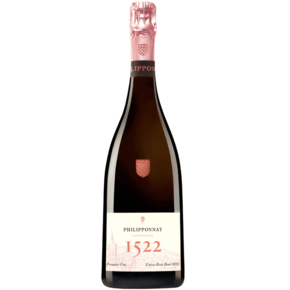Philipponnat - Cuvée 1522 Rosé Extra Brut 2012
| Distrikt | Vallée de la Marne |
| Druvor | Chardonnay, Pinot Noir |
| Årgång | 2012 |
| Procucenter | Champagne från Philipponnat |
| Artikelnr | Philipponnat 111 |
| Lagerstatus | |
| Fraktkostnad | 169:- |
Här redovisar och presenterar vi kända vinskribenters utlåtande om specifika viner. Utöver dessa lägger vi in en egen kommentar när vi har provat samma vin.
Decanter Magazine
This Extra-Brut Rosé is composed of 73% Pinot Noir and 27% Chardonnay. It is already showing a vibrant, fresh, distinctive bouquet with raspberry, strawberry, orchard fruit and lemon. Full-bodied, its elegantly fleshy, with depth and core, and concludes with a long, penetrating finish. I strongly recommend waiting at least a few years before popping corks to realise this wines considerable potential. Disgorged: March 2021. Dosage: 4.5 g/L.
Wine Enthusiast
Vineyards around A˙ form the basis of this dry rosé Champagne. The richness balances the dry style, bringing out the ripe fruits as much as zesty acidity. Drink this wine now.
Andreas Larsson - Tasted
Bright and pale colour with a copper hue and vivid small bubbles. Pure and intense perfume showing confit de citron, raspberry, marzipan, fine pastry and fresh butter. Distinct and grippy palate with good concentration marrying ripe fruit notes with a brilliant freshness, soft and supple creaminess, good autolytic complexity with fine nutty notes, light toast and wild strawberry flavours. Long and really persistent finish.
Champagne Club by Richard Juhlin
Fine seriousness with stringency, modest oak character, leathery A˙ bouquet with animalic overtones and a touch of hazelnut and incipient chocolate scent. Rich dry and gastronomic.
Robert Parker Wine Advocate
Disgorged in March 2021 with 4.5 grams per liter dosage, Philipponnat's 2012 Extra-Brut Rosé Premier Cru 1522 offers up deep aromas of red berries, spices, bitter orange, plums and fresh bread. Medium to full-bodied, deep and vinous, it's layered and concentrated, with bright girdling acids and delicate structuring phenolics. Long and penetrating, it's as fine a rendition of this cuvée as I can remember tasting.
As I've written before, Charles Philipponnat took the reins at this historic house in Mareuil-sur-Ay in 1999, initiating a remarkable renaissance that continues to this day. The flagship wine remains the Clos des Goisses, first produced in 1935: this steep, south-facing site is one of Champagne's ripest terroirs and produces what is arguably the region's longest-lived wine; it's the source of many of the greatest old Champagnes that I've ever tasted. And I suspect his experience with the Clos des Goisses informs Charles Philipponnat's pursuit of elevated maturity, his decision to generally block malolactic fermentation and his minimalist approach to dosage. Recent years have seen a new series of lieu-dit bottlings from within the Clos des Goisses, taking the idea of terroir Champagne that this house pioneered back in 1935 even further. And in the last few years, the
Druvor
62% Pinot Noir från Le Léon vingård i Aÿ och från Mailly och 27% Chardonnay från Verzy, till vilken 11% Pinot Noir tillsatts, vinifierat som rött vin, från Mareuil-sûr-Aÿ vingårdarna.
En del av vinerna vinifieras på träfat utan malolaktikjäsning för att bevara vinets fräschör, vilket gör att det kan utveckla komplexitet. Den rosa färgen erhålls genom att tillsätta ett stilla Pinot Noir-vin (vanligtvis från Clos des Goisses) under den inledande blandningsprocessen. Denna cuvée är både riklig och syrlig och lämpar sig utmärkt för låga doser: extrabrut, med endast 4,25 g socker per liter, vilket är bara en tredjedel av den konventionella dosen för en brutal champagne.
Degorgerad: March 2021. Dosage: 4.5 g/L.
Tasting note
Disgorged in March 2021 with 4.5 grams per liter dosage, Philipponnat's 2012 Extra-Brut Rosé Premier Cru 1522 offers up deep aromas of red berries, spices, bitter orange, plums and fresh bread. Medium to full-bodied, deep and vinous, it's layered and concentrated, with bright girdling acids and delicate structuring phenolics. Long and penetrating, it's as fine a rendition of this cuvée as I can remember tasting.
As I've written before, Charles Philipponnat took the reins at this historic house in Mareuil-sur-Ay in 1999, initiating a remarkable renaissance that continues to this day. The flagship wine remains the Clos des Goisses, first produced in 1935: this steep, south-facing site is one of Champagne's ripest terroirs and produces what is arguably the region's longest-lived wine; it's the source of many of the greatest old Champagnes that I've ever tasted. And I suspect his experience with the Clos des Goisses informs Charles Philipponnat's pursuit of elevated maturity, his decision to generally block malolactic fermentation and his minimalist approach to dosage. Recent years have seen a new series of lieu-dit bottlings from within the Clos des Goisses, taking the idea of terroir Champagne that this house pioneered back in 1935 even further. And in the last few years, the "L.V."—or "Long Vieillissement"—range has formalized Philipponnat's already extant late-disgorgement program. All these recent releases come warmly recommended.
Robert Parker Wine Advocate
-
Årgång 2012 i Champagne
★★★★
En riktigt knepig odlingssäsong med många svårigheter fick ändå ett lyckligt slut. Efter frostproblem, regnöverskott och kyla blev mognadsperioden sammantaget den torraste sedan 1974. Skörden blev liten men mycket fin och gav balanserade, eleganta och snygga viner med en ungdomligt potent frukt.
Många är väldigt tilltalande från start men bör lagras ett tag till för full mognad. De flesta bör dock drickas mellan tolv och tjugo år gamla då den verkliga kraften saknas. De främsta exemplaren som släppts hittills är Cristal, Cristal Rosé, La Grande Dame, De Sousa Caudalies, Piper-Heidsieck, Belle Époque, Bollinger La Grande Année, Thineot/Penfolds Blanc de Blancs och Bollinger La Grande Année Rosé. Noterbart är att Krug valde att avstå årgångsvin detta år och i stället satsade på en mycket fin Krug Grande Cuvée med 2012 som bas.
-
Champagne Club by Richard Juhlin





